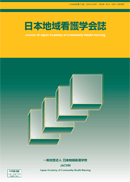Volume 20, Issue 1
Displaying 1-9 of 9 articles from this issue
- |<
- <
- 1
- >
- >|
Original Articles
-
2017Volume 20Issue 1 Pages 4-12
Published: 2017
Released on J-STAGE: April 20, 2018
Download PDF (1022K) -
2017Volume 20Issue 1 Pages 13-21
Published: 2017
Released on J-STAGE: April 20, 2018
Download PDF (1007K) -
2017Volume 20Issue 1 Pages 22-30
Published: 2017
Released on J-STAGE: April 20, 2018
Download PDF (997K)
Research Reports
-
2017Volume 20Issue 1 Pages 31-40
Published: 2017
Released on J-STAGE: April 20, 2018
Download PDF (1029K) -
2017Volume 20Issue 1 Pages 41-50
Published: 2017
Released on J-STAGE: April 20, 2018
Download PDF (991K) -
2017Volume 20Issue 1 Pages 51-61
Published: 2017
Released on J-STAGE: April 20, 2018
Download PDF (997K)
Community Health Nursing Report
-
2017Volume 20Issue 1 Pages 62-68
Published: 2017
Released on J-STAGE: April 20, 2018
Download PDF (974K)
Informations
-
2017Volume 20Issue 1 Pages 69-78
Published: 2017
Released on J-STAGE: April 20, 2018
Download PDF (1015K) -
2017Volume 20Issue 1 Pages 79-85
Published: 2017
Released on J-STAGE: April 20, 2018
Download PDF (929K)
- |<
- <
- 1
- >
- >|
